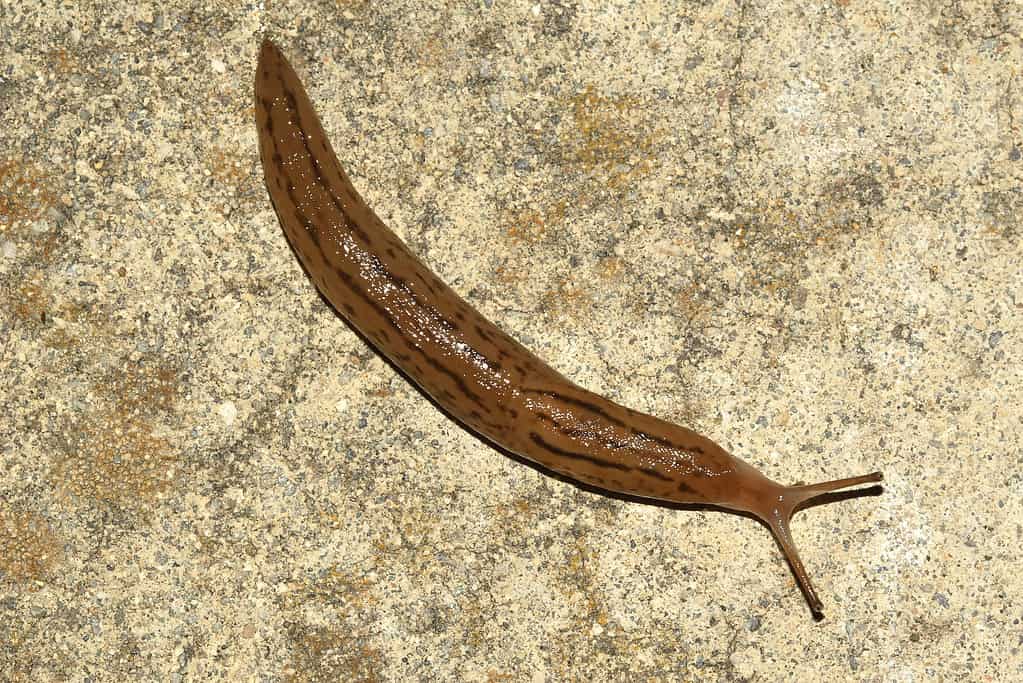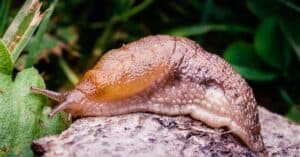Gardens prove valuable for several reasons. For many, these collections of plant life enable people to grow healthy and nutrient-rich natural products. To others, gardens provide a relaxing hobby helping them escape the stresses of everyday life. Unfortunately, however, gardens also attract unwanted guests. One specific and especially troublesome visitor is the garden slug. Discover the most effective DIY solutions to deter garden slugs.

The garden slug’s body appears moist and slimy.
©Sanjay Acharya, CC BY-SA 3.0 – License
What Is a Garden Slug?
The garden slug, known scientifically as Arion hortensis, is a type of mollusk similar to a snail. The insect also goes by other names such as the small-striped slug and the black-field slug.
What Do Garden Slugs Look Like?
Insect experts suggest that the garden slug looks like a snail without a shell. Typically, their muscular, legless bodies appear brown or greyish and extend anywhere from a quarter-inch to two inches long.
Additionally, the garden slug’s body appears moist and slimy. The critter’s most unique feature is its head, which contains two thin, pencil-point-like objects called feelers that help it see and smell.
When Are Garden Slugs Most Often Seen?
Garden slugs thrive in damp, dark, and cool soil. Heat and sunlight threaten their well-being. Therefore, the insects will most likely be seen during the evening or on overcast days. Moreover, the garden slug population peaks during the spring and summer months following the birth of their young. However, they often remain active well into the fall.
What do Garden Slugs Eat?
Usually, garden slugs feed on plant life capable of growing in cooler, darker soil not reliant on much sunlight.
The insects favor produce such as:
- Strawberries
- Basil
- Beans
- Lettuce
- Cabbage
- Tomatoes
In terms of plants, garden slugs commonly feed on:
- Dahlia
- Bellflower
- Larkspur
- Plaintain lily
- Day lily
Sometimes, the garden slug makes its way into tree bark. Citrus trees bearing oranges and lemons often fall prey.

Slugs can eat plants faster than they can grow.
©Dieter Hawlan/iStock via Getty Images
Signs Suggesting the Presence of Garden Slugs
Since garden slugs and people typically have different working hours, spotting them can prove difficult. Fortunately, however, insect experts caution that red-flag signs like the appearance of holes or gaps in produce or other vegetation mean a problem likely exists and must soon be addressed.
Damage Caused by Garden Slugs
The specific extent of damage caused by garden slugs depends on how much the insects feed on a particular plant or produce product.
Small or moderate garden infestations typically result in minor damage that does not threaten the foliage’s health. However, large slug populations often lead to notable damage capable of killing plants and crippling produce harvests. Such events could cost the farming industry hundreds of thousands or even millions of dollars.
Effective DIY Solutions to Deter Garden Slugs
Luckily, certain do-it-yourself methods have proven effective in keeping slug populations in check. Such efforts include:
Installing Barriers
Certain slug barriers might prove beneficial. Copper foil provides an electrical-like shock to slugs and most often works when lined around smaller gardens. Occasionally, diatomaceous earth, which is a fine, coarse, ground-up material scratches and irritates a slug’s body.
Beer
Believe it or not, beer often produces positive results. The yeast contained in the popular beverage attracts garden slugs. Therefore, gardeners are encouraged to place a small amount of the malt beverage inside an open dish and leave it in a central location within the foliage.
Practicing Proper Maintenance
Proper maintenance often proves critical. Taking steps like trimming vegetation to allow more sunlight to enter the garden, improving soil drainage, and promoting better air circulation makes the surrounding environment less appealing to slugs.
Allowing Nature to Take its Course
Slugs have certain natural enemies such as toads, turtles, and various snakes. The presence of these predators may reduce a garden’s slug population.
The photo featured at the top of this post is © iStock.com/Ja'Crispy
Thank you for reading! Have some feedback for us? Contact the AZ Animals editorial team.






